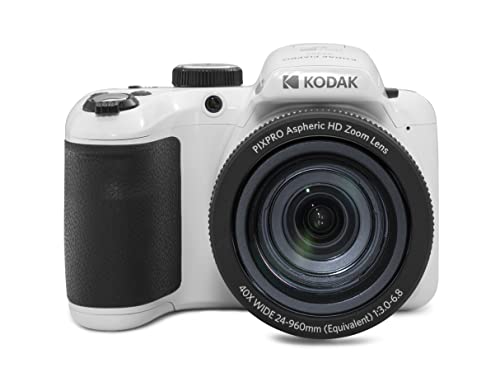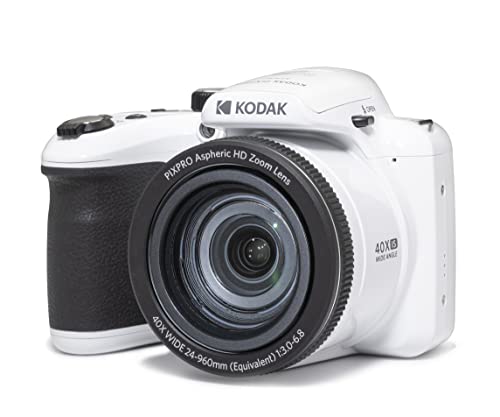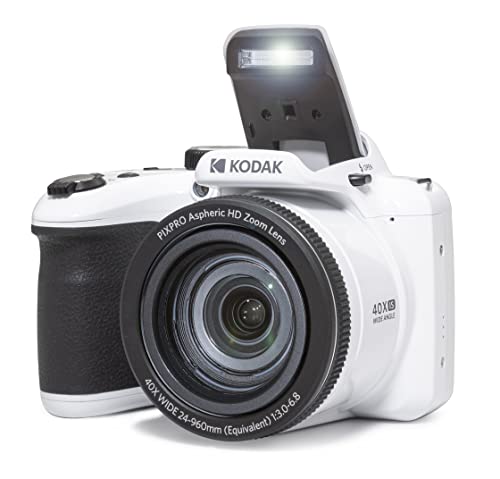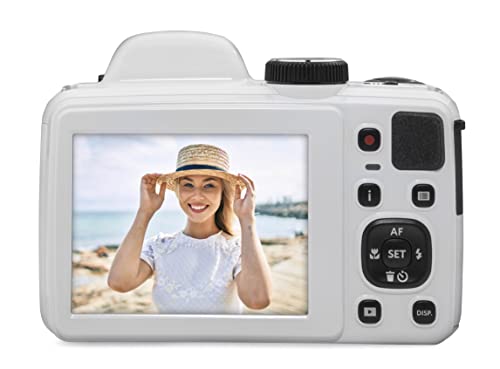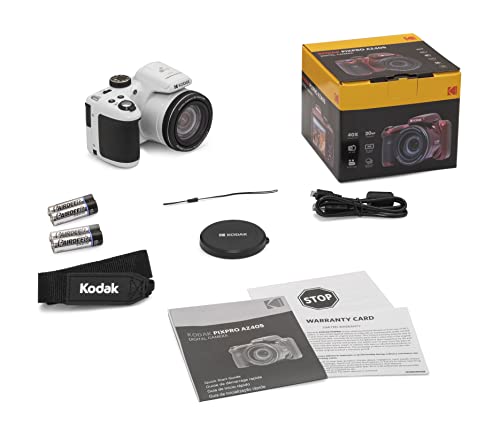

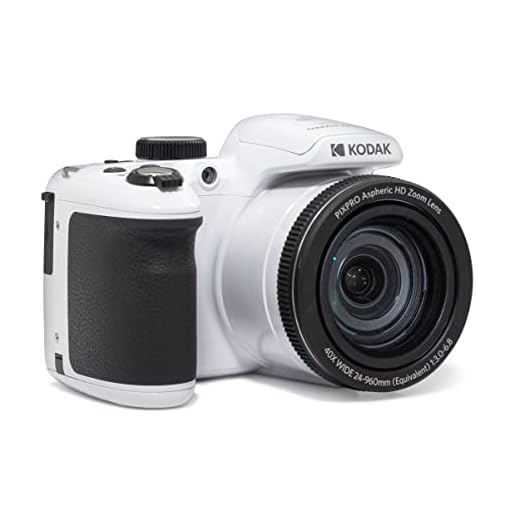


When it comes to capturing sharp and clear images, having the right camera can make all the difference. As a photography enthusiast, I have always been on the lookout for the best digital camera that offers exceptional sharpness. After thorough research and personal experience, I am excited to share my top recommendations for the best digital camera for sharpness.
1. Canon EOS 5D Mark IV
The Canon EOS 5D Mark IV is a full-frame DSLR camera that is renowned for its incredible sharpness and image quality. With a 30.4-megapixel sensor and advanced image processing, this camera delivers stunningly sharp and detailed photos. It also features Dual Pixel CMOS AF for fast and accurate autofocus, ensuring that your subjects are always in focus.
2. Sony A7R IV
The Sony A7R IV is a mirrorless camera that boasts an impressive 61-megapixel sensor, making it one of the highest-resolution cameras on the market. This camera utilizes Sony’s advanced technology to deliver exceptional sharpness and detail in every shot. It also has a fast autofocus system and 5-axis image stabilization, ensuring that your images are not only sharp but also free from blur.
3. Nikon D850
The Nikon D850 is a professional-grade DSLR camera that offers outstanding sharpness and image quality. With its 45.7-megapixel sensor and advanced EXPEED 5 image processing, this camera captures incredibly detailed and sharp photos. It also features a precise autofocus system and a wide dynamic range, allowing you to capture even the most challenging scenes with clarity.
Choosing the best digital camera for sharpness ultimately comes down to personal preference and budget. However, these three cameras – the Canon EOS 5D Mark IV, Sony A7R IV, and Nikon D850 – are all excellent choices for capturing exceptionally sharp and detailed images.
The Importance of Sharpness in Digital Cameras
When it comes to digital photography, one of the most important factors to consider is the sharpness of the images produced by a camera. Sharpness plays a vital role in capturing details, enhancing image quality, and achieving professional-looking results. Whether you are a professional photographer or an amateur enthusiast, having a camera with excellent sharpness capabilities can make a significant difference in the outcome of your photographs.
Sharpness is essential for capturing details. When photographing a subject, whether it’s a landscape, a portrait, or a product, the ability to capture fine details can make your images come to life. A sharp image allows you to see intricate textures, precise lines, and small nuances that may not be visible in a blurry or soft photo. It gives your photos depth and dimension, making them more engaging and visually appealing.
Sharpness enhances image quality. A sharp photo is generally considered to have higher image quality compared to a blurry or soft one. It gives your images a sense of clarity and crispness, making the colors and tones appear more vibrant and accurate. Sharpness also helps to reduce digital noise and artifacts, resulting in cleaner and more professional-looking photographs.
Sharpness contributes to professional results. Whether you are capturing images for personal enjoyment or for professional purposes, having sharp and detailed photographs can greatly elevate the overall look and impact of your work. Sharpness is often associated with professionalism in photography and can make your images stand out from the crowd. It shows that you have paid attention to the technical aspects of photography and have taken the time to ensure that your images are as crisp and clear as possible.
In conclusion, sharpness is a crucial factor to consider when choosing a digital camera. It can significantly impact the quality and impact of your photographs by allowing you to capture fine details, enhancing image quality, and achieving professional-looking results. So, whether you are a professional photographer or an amateur enthusiast, investing in a camera with excellent sharpness capabilities is definitely worth considering.
Understanding Sharpness and Its Impact on Image Quality
As a photography enthusiast, I have always been fascinated by the concept of sharpness and its role in capturing high-quality images. Sharpness is defined as the clarity and level of detail that can be perceived in a photograph. It is one of the key factors that contribute to the overall image quality and can greatly enhance the visual impact of a photo.
Sharpness is affected by various factors, including the camera’s lens quality, the sensor resolution, and the photographer’s technique. A high-quality lens with good glass elements and advanced optical design can greatly improve the sharpness of the captured images. Additionally, a higher sensor resolution allows for finer details to be captured, resulting in sharper images.
When it comes to choosing the best digital camera for sharpness, it is important to consider the lens quality and the sensor resolution. A camera with a high-quality lens and a higher sensor resolution will generally produce sharper images. However, it is also important to note that sharpness is not solely dependent on the camera’s specifications, but also on the photographer’s skill and technique.
In addition to the camera’s hardware, post-processing techniques can also play a crucial role in enhancing the sharpness of an image. Various software tools and techniques, such as sharpening filters, can be used to enhance the overall sharpness and clarity of a photograph. It is important to strike a balance between enhancing the sharpness without introducing artifacts or sacrificing the natural look of the image.
Overall, sharpness is an important aspect of image quality and can greatly impact the visual appeal of a photograph. By understanding the various factors that affect sharpness and utilizing the right equipment and techniques, photographers can capture stunningly sharp and detailed images.
Factors that Affect Sharpness in Digital Cameras
As a photographer, I understand the importance of sharpness in digital images. Achieving sharpness is not solely dependent on the quality of the camera, but various factors come into play. Here are some key factors that affect sharpness in digital cameras:
1. Lens Quality
The quality of the lens used in a digital camera plays a crucial role in determining image sharpness. High-quality lenses with superior optics, coatings, and construction can greatly enhance sharpness. A lens with a larger aperture and precise focusing capabilities can help capture sharper details in photographs.
2. Sensor Resolution
The resolution of the camera’s sensor also affects sharpness. A higher resolution sensor can capture more details, leading to sharper images. It is essential to choose a camera with a sensor that offers sufficient resolution for the desired level of sharpness in your images.
3. Image Stabilization
Image stabilization technology is another factor that affects sharpness. Camera shake can lead to blurry images, especially in low light conditions or when using longer focal lengths. Optical or sensor-based image stabilization systems can minimize camera shake and improve the sharpness of images.
4. Settings and Technique
Proper camera settings and technique also contribute to image sharpness. Shooting in RAW format allows more flexibility in post-processing to enhance sharpness. Using appropriate focus techniques, such as manual focus or selecting the right autofocus point, can help achieve better sharpness in specific areas of the frame.
A photo may have the latest camera model with top-notch features, but without considering these factors, it may lack the desired sharpness. By understanding and optimizing these elements, photographers can greatly improve the sharpness of their digital images.
How Sharpness is Measured in Digital Cameras
As a photographer, I know the importance of sharpness in capturing stunning images. When it comes to digital cameras, sharpness is one of the key factors to consider. But how is sharpness actually measured in these cameras? Let’s delve into this subject to gain a better understanding.
Sharpness in digital cameras is determined by a combination of factors, including lens quality, image sensor resolution, and image processing algorithms. The lens quality plays a crucial role in capturing sharp images, as it determines the level of distortion and aberrations. High-quality lenses with advanced optics can minimize these issues and result in sharper images.
In addition to the lens, the image sensor resolution also affects the sharpness of the captured images. Higher resolution sensors can capture more details, providing a sharper image. However, it’s important to note that simply having a higher resolution does not guarantee sharpness. The image sensor’s sensitivity to light and the presence of an anti-aliasing filter also impact the overall sharpness of the image.
Moreover, digital cameras employ image processing algorithms that enhance sharpness during post-processing. These algorithms analyze the image data and apply techniques like edge enhancement and noise reduction to improve the perceived sharpness. However, excessive sharpening can result in artifacts and loss of natural details, so a balance must be struck.
In conclusion, sharpness in digital cameras is determined by a combination of factors including lens quality, image sensor resolution, and image processing algorithms. The lens quality affects distortion and aberrations, while higher resolution image sensors capture more details. Image processing algorithms enhance sharpness during post-processing, but it’s important to strike a balance to avoid artifacts. Understanding these factors can help photographers make informed decisions when choosing a digital camera for maximum sharpness.
Top Features to Look for in a Digital Camera for Sharpness
When searching for the best digital camera for sharpness, there are several key features that I consider essential. These features play a crucial role in capturing high-quality and detailed images. Here are some of the important features that I always look for:
Image Sensor: The image sensor is the heart of a digital camera and has a significant impact on the sharpness of the images. Look for cameras with larger image sensors as they can capture more details and produce sharper images. Full-frame and APS-C sensors are typically known for their superior sharpness.
- Resolution: Higher resolution cameras tend to produce sharper images. Look for cameras with at least 20 megapixels or more for optimal sharpness.
- Lens Quality: The quality of the lens plays a crucial role in the sharpness of the images. Look for cameras that offer high-quality lenses with a low level of distortion and great optical performance. Lenses with advanced glass elements or coatings can help enhance overall sharpness.
- Image Stabilization: Cameras with built-in image stabilization technology help reduce camera shake, resulting in sharper images. Look for cameras that offer optical or sensor-shift image stabilization for better sharpness, especially in low-light conditions or when using telephoto lenses.
- Focus System: The autofocus system of a camera is another important factor to consider for sharpness. Look for cameras that offer advanced autofocus systems with multiple focus points, fast and accurate tracking, and capabilities for precise focusing.
- RAW Capture: Shooting in RAW format allows for more flexibility during post-processing and can help enhance sharpness. Look for cameras that offer RAW capture capabilities to have greater control over sharpness and other parameters in the editing process.
These are some of the key features that I prioritize when looking for a digital camera that delivers excellent sharpness. Each of these features contributes to capturing detailed and sharp images, providing a superior photography experience.
High Megapixel Count
When it comes to digital cameras, one of the key factors that many photographers consider is the megapixel count. A higher megapixel count generally means a larger image sensor, which can result in greater detail and sharpness in the final image. As a photographer, I understand the importance of capturing every minute detail in my shots, and a high megapixel count is an essential feature that I look for in a digital camera.
With a high megapixel count, I can confidently capture images with intricate details, whether it’s the fine texture of a flower petal or the pattern on a butterfly’s wing. The increased resolution allows for crisper and more vibrant images, even when zooming in or cropping the photo. This is particularly useful when working with post-processing software, as I can retain more information and achieve better results with my edits, without sacrificing the sharpness of the image.
Advantages of a High Megapixel Count:
- Greater detail and sharpness in images
- Ability to crop and zoom without losing quality
- Better results in post-processing
- Overall improved image quality
However, it’s important to note that a high megapixel count alone does not guarantee sharpness in photographs. Factors such as lens quality, image stabilization, and proper technique also play a significant role. It’s crucial to have a balanced approach and consider all aspects of a camera’s capabilities before making a decision based solely on the megapixel count.
Ultimately, a high megapixel count can be a valuable feature for photographers who prioritize sharpness and detail in their images. It allows me to capture the world around me with incredible precision and ensures that every photo I take is of the highest quality.
Optical Image Stabilization
When it comes to capturing sharp images, one important feature to consider in a digital camera is Optical Image Stabilization. This technology helps to reduce camera shake, resulting in clearer and sharper photos.
Optical Image Stabilization works by using a set of gyroscopic sensors that detect camera movement. The camera then compensates for this movement by adjusting the lens elements or image sensor. This correction helps to eliminate blurry images caused by hand movements or vibrations.
There are two types of Optical Image Stabilization:
- Optical lens-based stabilization: This type of stabilization is built into the camera lens. It uses floating lens elements that move in response to camera movements and counteract them. This method is effective in reducing both small and large camera movements, resulting in sharper images.
- Sensor-shift stabilization: This type of stabilization is built into the camera body and works by moving the image sensor to counteract camera movements. The camera detects any shake or movement and adjusts the position of the sensor accordingly. While this method is effective in reducing small camera movements, it may not be as effective with larger movements.
Overall, Optical Image Stabilization is a crucial feature when it comes to capturing sharp and clear images. Whether you choose a camera with lens-based stabilization or sensor-shift stabilization, both technologies can greatly improve the sharpness of your photos by reducing the impact of camera shake. So, when choosing the best digital camera for sharpness, be sure to prioritize models with Optical Image Stabilization.
Best digital camera for sharpness
Features
| Part Number | 1159C003 K1 |
| Model | Canon T6 K1 |
| Warranty | B01D93Z89W |
| Color | Black |
| Release Date | 2018-08-01T00:00:01Z |
| Price history for Canon EOS Rebel T7 DSLR Camera Bundle | |
|---|---|
|
Latest updates:
|
|
Features
| Part Number | BMSLY420CNK2 |
| Model | 4332060496 |
| Price history for High-Power 420-1600mm Telephoto Zoom Lens | |
|---|---|
|
Latest updates:
|
|
Features
| Part Number | AZ405-WH |
| Model | AZ405-WH |
| Warranty | 1 year manufacturer |
| Color | White |
| Release Date | 2022-11-05T00:00:01Z |
| Language | English |
| Price history for KODAK PIXPRO AZ405-WH Digital Camera | |
|---|---|
|
Latest updates:
|
|
Features
| Model | W08 |
| Color | YL15-W08-C-Black |
| Is Adult Product |
Features
| Part Number | DC-FZ80DK |
| Model | DC-FZ80DK |
| Warranty | 1 Year Manufacturer |
| Color | Black |
| Release Date | 2024-08-01T00:00:01Z |
Features
| Part Number | DC402-AF |
| Model | DC402 |
| Color | Black |
| Size | Compact |
Question and answers:
Which digital camera delivers the best sharpness?
Many professional photographers and camera enthusiasts consider the Sony Alpha A7R IV to be the best digital camera for sharpness. With its high-resolution 61-megapixel sensor and advanced image processing capabilities, it can capture incredibly detailed and crisp images.
Is there a specific brand known for producing cameras with excellent sharpness?
Sony is widely recognized as a brand that produces cameras with exceptional sharpness. Their Alpha series, including models like the Sony Alpha A7R IV and Sony Alpha A7R III, are particularly renowned for their high-resolution sensors and superior image quality.
Are there any budget-friendly digital cameras that offer good sharpness?
Yes, there are several budget-friendly options that offer good sharpness. The Nikon D3500 and Canon EOS Rebel T7i are popular entry-level DSLR cameras known for their sharp image quality. Additionally, mirrorless cameras like the Sony Alpha A6000 and Fujifilm X-T200 are also praised for their sharpness at a more affordable price point.

















